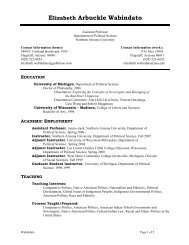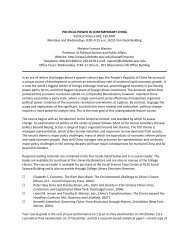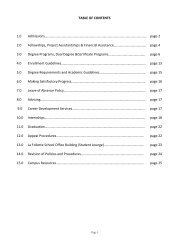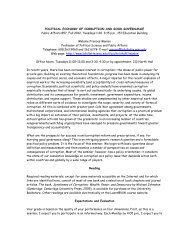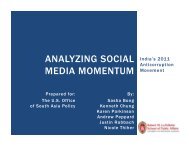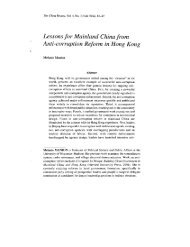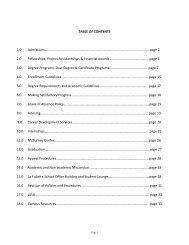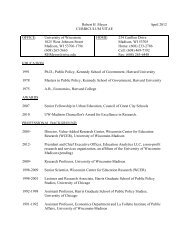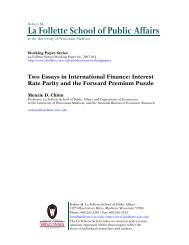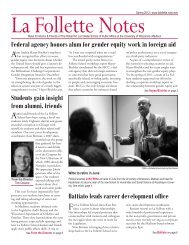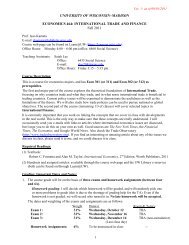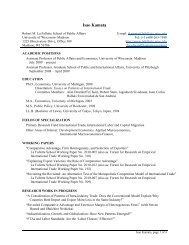SAVE Commission's findings - La Follette School of Public Affairs ...
SAVE Commission's findings - La Follette School of Public Affairs ...
SAVE Commission's findings - La Follette School of Public Affairs ...
Create successful ePaper yourself
Turn your PDF publications into a flip-book with our unique Google optimized e-Paper software.
GOAL #6: GENERATIONS THAT CONNECT<br />
6.1<br />
6.2<br />
Consolidate youth functions. To reduce duplication<br />
and provide a focal point for future<br />
youth initiatives, consolidate and coordinate<br />
services including employment, recreation,<br />
corrections, pregnancy prevention, mental<br />
health, youth alcohol and drug abuse, and education.<br />
Plan for aging <strong>of</strong> society. To cope with the<br />
anticipated “crisis” <strong>of</strong> great numbers <strong>of</strong> the very<br />
elderly, static resources and desire for independence,<br />
all parties involved with older adults<br />
should work more closely to unify policies and<br />
purpose. This will require closer coordination<br />
<strong>of</strong>: financial resources, quality assurance and<br />
independent lifestyle. As part <strong>of</strong> the strategy,<br />
reduce duplication and provide a focal point<br />
for initiatives and responsibilities associated<br />
with older adults.<br />
GOAL #7: LAND USE<br />
7.1<br />
Examine tax policy impacts on land use. To<br />
assess the link between taxes and land use,<br />
examine state policies which affect the value<br />
<strong>of</strong> land, including urban in-fill areas and open<br />
space, and recommend <strong>findings</strong> to existing<br />
committees studying land use.<br />
7.2<br />
Reduce the illogical impact <strong>of</strong> boundaries on<br />
service. To protect open space from poorly<br />
planned development, communities should<br />
think about the good <strong>of</strong> the entire area when<br />
deciding the most cost effective and environmentally<br />
responsible service delivery system.<br />
7.3<br />
Evaluate the impact <strong>of</strong> infrastructure changes.<br />
To provide decision makers with better information,<br />
greater attention should be paid to the<br />
total community impact <strong>of</strong> infrastructure<br />
changes.<br />
7.4<br />
Play an active role in federal decisions affecting<br />
land. To better protect the state’s economic<br />
and environmental interests, the state should<br />
better coordinate its position on federal programs<br />
as they affect land use, especially as federal<br />
direction undergoes major change.<br />
7.5<br />
Reward good behavior. To promote stewardship<br />
partnerships, agencies concerned with<br />
land use should promote voluntary programs<br />
such as the Conservation Credit initiative as<br />
7.6<br />
7.7<br />
7.8<br />
applied in Pepin County and partnerships with<br />
groups that provide credits to landowners with<br />
environmentally sensitive land.<br />
Require results for conservation programs. To<br />
comply with Legislative Audit Bureau recommendations,<br />
the state’s investments in watershed<br />
and erosion control should produce measurable<br />
outcomes or be discontinued.<br />
Local government should be better neighbors<br />
on annexation. To reduce distrust and contentiousness,<br />
local governments should be<br />
more creative and collaborative toward resolution<br />
<strong>of</strong> annexation issues.<br />
Broaden membership on state government’s<br />
land use committee. To ensure that non-state<br />
government interests can participate in discussions<br />
about land use policies, the state should<br />
involve business, agricultural, development,<br />
environmental, local government and citizen<br />
interests on its committee.<br />
GOAL #8: THE NEW INFRASTRUCTURE<br />
8.1<br />
Coordinate planning for energy-utility-transportation<br />
rights <strong>of</strong> way. To reduce duplicative<br />
planning costs and concentrate intensified land<br />
use, develop an integrated approach to corridor<br />
planning for compatible energy, communications,<br />
utility and transportation functions<br />
with safeguards. Establish a high level publicprivate<br />
commission to recommend 21st Century<br />
approaches to better corridor planning.<br />
8.2<br />
Go slow on state building and rethink infrastructure<br />
needs. To take a cautious approach<br />
to new state buildings in a time <strong>of</strong> government<br />
and higher educational “rightsizing”, consider<br />
public infrastructure, state and university<br />
buildings as possible liabilities, not assets.<br />
Owning “single use” facilities in a high-tech,<br />
distance-learning age may be very costly. Review<br />
the process <strong>of</strong> planning, approving, building<br />
and using structures and go slow on new<br />
construction in the meantime.<br />
8.3<br />
Consider market mechanisms and other new<br />
tools to achieve infrastructure development<br />
and operation goals. To open the door to new<br />
ways <strong>of</strong> thinking about planning, financing and<br />
managing public infrastructure, we should<br />
study, experiment with and apply new tools<br />
such as congestion pricing or regional “certifi-<br />
62 CITIZEN • COMMUNITY • GOVERNMENT — WISCONSIN: THE 21 ST CENTURY



